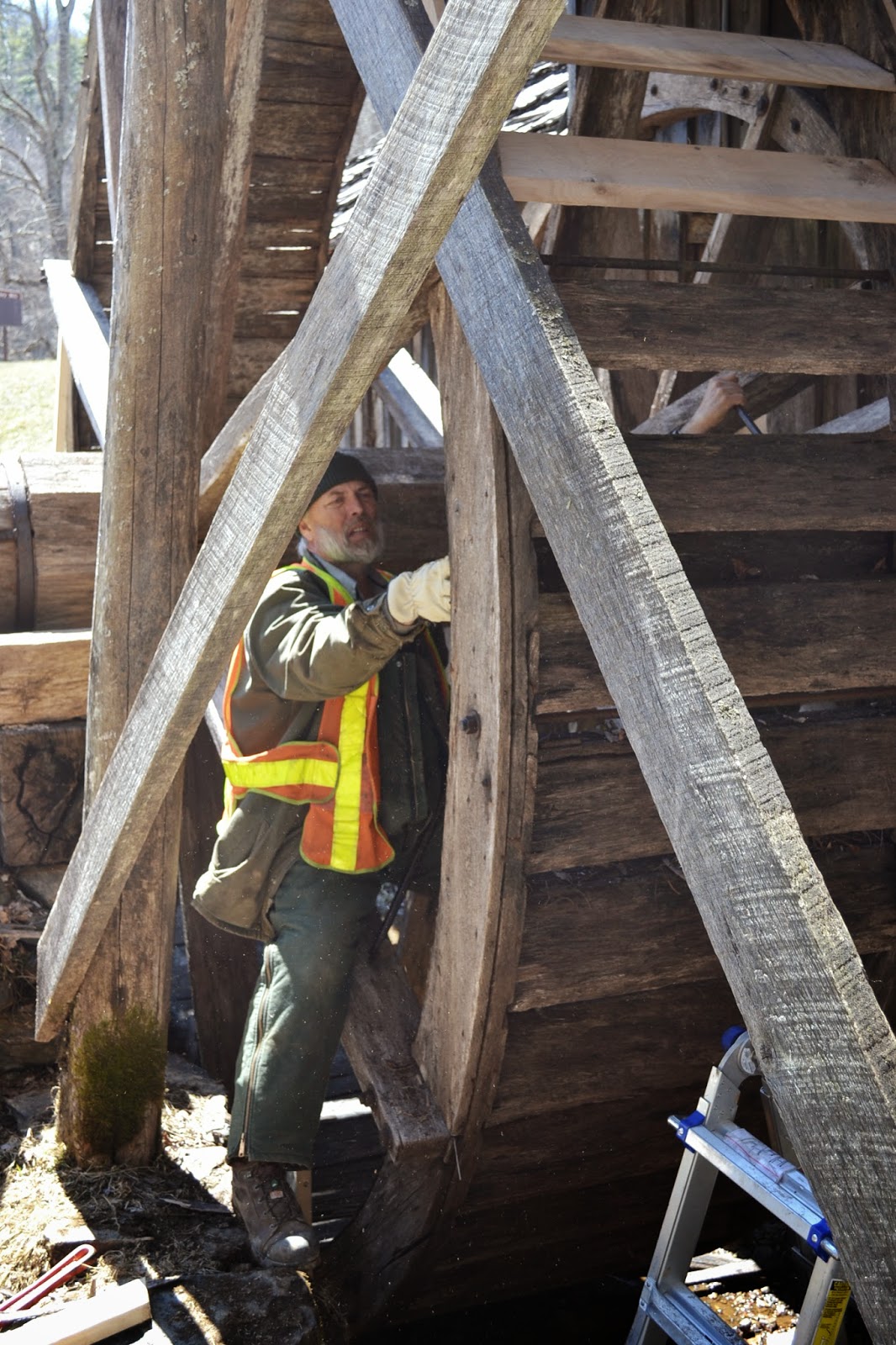 |
| Mabry Mill, as it looked about 1 p.m. on March 24. Photos by Jack Betts, Rocky Knob Writery LLC |
In the current remaking, a project sponsored by the Blue Ridge Parkway Foundation, the result would have to reflect a respect for the old ways of doing things, but in order to do it in a matter of weeks, new tools powered by electricity as well as human muscle would be used. The Foundation allotted $65,000 for the reconstruction project, which included dredging the millpond and repairing the water flume as well as replacing parts of the waterwheel. Those who wish to contribute to the project, or to the Foundation generally, can find out how online at brpfoundation.org or by calling 1-866-308-2773.
 |
| The axle and spokes are in good shape and don't have to be replaced, but many other parts must be renewed |
The plan for this reconstruction at first was to remove the wheel and ship it to the Historic Preservation Shop near Blowing Rock, no doubt to be rebuilt the same way, somewhere between knee level and chest level. But earlier this year, the Parkway revised its plans; component parts would be cut at the shop in Watauga County, N.C., then brought to the Mabry Mill site on the Parkway in Virginia. The waterwheel would be rebuilt in place -- upright, on the axle, and not to put too fine a point on it, capable of turning in place at any moment unless it was locked in place.
 |
| Waterwheel under reconstruction -- with a high-tech 2x4, at left, locking the wheel in place |
There is one reasonable point of access to all the component parts of this particular standing waterwheel -- barely room enough, just to the right of the big wooden blocks that hold up the outboard end of the axle, for three men to clamber around inside and just outside the wheel, right below the point where the water flume ends and right in that dug-out portion of the creek that provides room for the big wheel's lower half to whirl smoothly after each bucket dumps its water load and moves around towards the top to collect its next load. The other side of the big pillow blocks holding up the waterwheel is just thin air, and then some good cold muddy water, because that's where the reflecting pond begins.
 | ||
| David Cannaday, sitting in the wheel, removing old bucket boards and replacing with the new components |
Working in these awkward positions made the job tougher. There were long threaded rods to be removed, then worn out backing boards and bucket bottoms and always old, rusty nails. Some could be pulled out; others could only be sawn through with a big tough reciprocating tool called a Sawzall. I've heard backyard carpenters refer to these things a "Rambo" after the weapon carried by movie character John Rambo. If you've got to remove something, or just tear it up, it's just the ticket. But in this case, Parkway employees used the Sawzall like a surgeon wields a scalpel -- making short cuts, just enough to get through the next obstruction, clear out the old and make way for the new.
 |
| Jack Trivett works part of a new bucket into the L-shaped grooves on the insides of the waterwheel. |
 |
| Steve Marmie pulls a bucket component into the slot |
The next photo shows one segment of new water buckets, awaiting new backing boards, on one of the eight sections of the waterwheel. This can be tedious work -- trying to maintain a high standard of craftsmanship on a structure that has been remade a number of times, with an array of different fasteners that can present all kinds of problems.
The work proceeded section by section, removing threaded rods and replacing them when the new bucket pieces were in place.
 |
| Jack Trivett, left, and Steve Marmie work on a bucket |
Once all the new bucket components were in place, white oak backing boards were fastened to the inside of the waterwheel, completing the basic three-piece bucket. Yet to come are strips of thinner white oak that have been soaking in a nearby Mabry Mill creek to keep them pliable and bendable before they go around the rims.
This next photo shows the waterwheel with a complete new set of buckets -- though a number of pieces are yet to be added. But first, there's a big job left -- replacing badly deteriorated blocks holding up the axle. Read about it next time in Chapter 6 of Rocky Knob Blog's series on the renewal of Mabry Mill.
The final photo shows how Mabry Mill's rebuilt waterwheel looked with new buckets on the afternoon of April 1.




What a labor of love! Congratulations to the Blue Ridge Parkway Foundation and to you for the fascinating tale of re-evolution (and re-revolution) of the Mill!--Wood
ReplyDelete